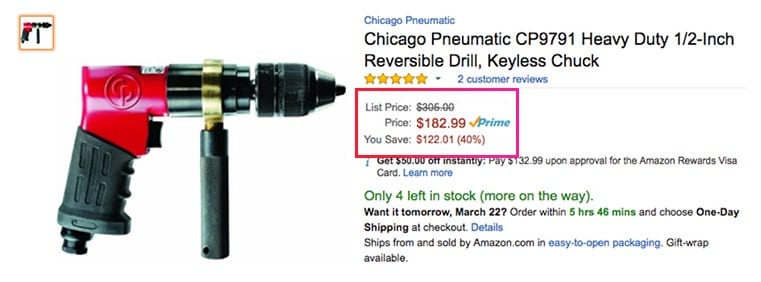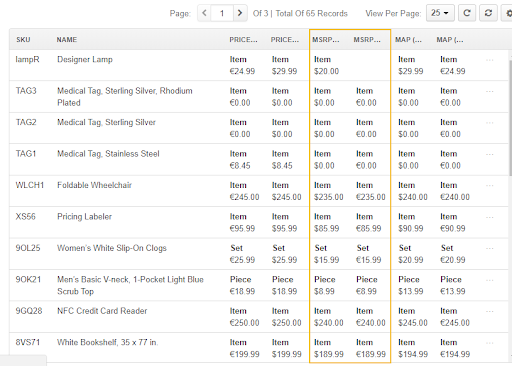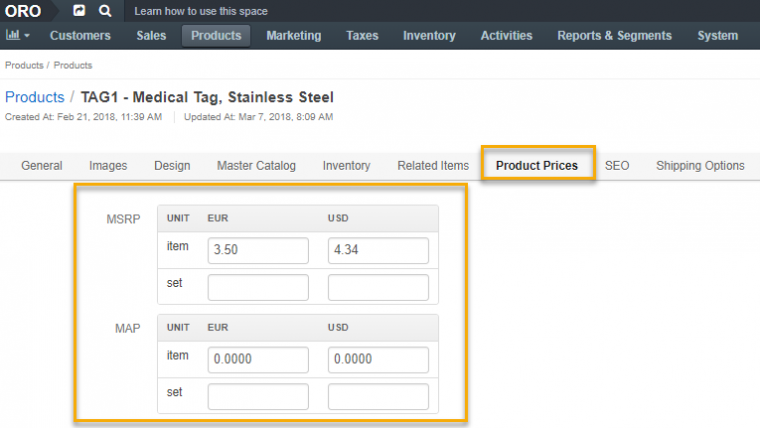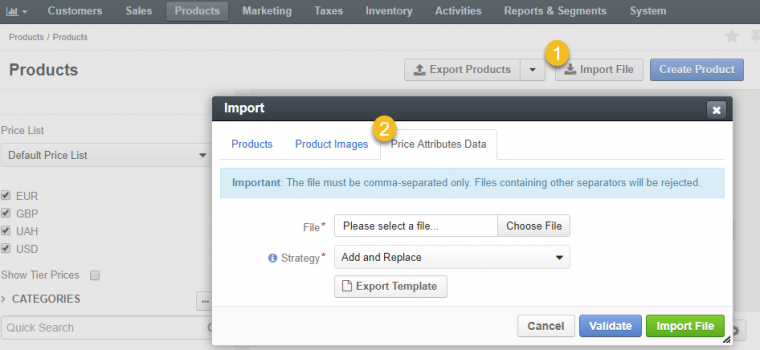navigation

Originally published on March 22, 2018, updated on July 20, 2021
Pricing is a hot topic for B2B brands and their customers alike. There are customer expectations to meet, profit margins to maintain, and channel conflict to avoid. Then there are various product configurations, value-added products, and promotions to track.
To gain control of their pricing strategy, promote competition among selling partners, and improve profitability, retailers can use manufacturers’ suggested retail price (MSRP) and minimum advertised price (MAP).
This post will discuss the importance of both MAP and MSRP pricing tools for B2B eCommerce manufacturers and distributors and how online sellers can implement them with the help of OroCommerce.
A Challenging Landscape for B2B Sellers
As shoppers move online and demand lower prices, more selection, and greater personalization, many brands have struggled to maintain an optimal pricing strategy.
Things get more complicated when dealing with B2B customers, as getting a good quality product that meets their needs takes precedence over getting the best possible price. In fact, according to an AMA study, getting a “fair price” was three times more important than getting the “lowest price” – and that is true for companies in parts distribution, raw materials, or engineering and construction.
At the same time, B2C trends, including pricing preferences, are quickly gaining popularity and make their way into the B2B world. Namely, B2B customers expect personalized prices, complete with eligible discounts and promotions they see as B2C customers. However, when making B2B eCommerce application decisions, B2B sellers look past personalized promotions and look for the ability to personalize offers to customers based on the company, order volume, and past experiences.
Even before the pandemic, over 40% of US manufacturers already sold direct to consumers. Over 2020, direct selling has seen a renaissance as manufacturers and distributors diversified their selling channels to stay afloat. But, manufacturer direct sales are not without the drawbacks, as it creates potential channel conflicts. It’s not uncommon for manufactures to leverage multiple channels such as B2B2B and sell in parallel on multiple retail networks.
The explosion of the third party B2B marketplace is giving rise to multi-vendor portals targeting whole ecosystems and industries. In many of these industries, Amazon remains the go-to destination. With heavy discounts for customers, it’s more difficult to keep up.
On the one hand, manufacturers want to fight back against discounters such as Amazon, where retailers are willing to give up their margins if it means reaching a wider audience. On the other hand, manufacturers need pricing consistency without negatively affecting their partner relationships and their margins. For these reasons, MSRP and MAP strategies are useful tools to help manufacturers maintain consistency, transparency, and level the playing for their retail partners.
MSRP vs MAP: Is Either Policy Right for You?
Let’s look deeper into the difference between MAP and MSRP pricing, how they’re relevant to the world of B2B eCommerce, and how B2B manufacturers can use these pricing strategies to their advantage.
What is MSRP?
Since manufacturers are generally not allowed to force retailers to sell at fixed prices, the manufacturer’s suggested retail price or MSRP is the ideal solution. As the name implies, it is the suggested retail price you recommend to distributors and retailers for your products. MSRP allows product pricing control through establishing a price standard and pricing parity across the resale channel.
MSRP is not set in stone and leaves room for retailers to sell goods at prices they consider most profitable. And since MSRP reflects all costs incurred in selling the product, from manufacturing and distribution to the retailer markup, it’s an ideal guideline for retailers.
As anyone who’s ever shopped for a car knows, the MSRP is what dealers usually use to price their vehicles. For car manufacturers, the MSRP is critical: it’s designed to offer customers transparent pricing, prevent price wars, and preserve desired margins for dealers. However, this figure isn’t fixed and will greatly depend on the invoice price – what the dealer originally pays the manufacturer, the desirability and availability of the car in question.
While the automotive industry is a complicated one, digital transformation is slowly making inroads here too, and pricing and financing transparency are becoming more important to buyers.

Just like car manufacturers, retailers can – and do – charge less than the MSRP. That’s because the MSRP is usually artificially inflated, and retailers take advantage of that by advertising a product at a much lower sale price so that consumers believe they’re getting a bargain.
In fact, Amazon started allowing sellers to set a “list price” and “your price” which even calculates the percentage saved to entice customers. Either way, as long as the price stays above the invoice, or the wholesale cost, the retailer will come out on top.
There’s one disadvantage, however. Aggressive discounting by one retailer can spark a price war and devalue the product, creating a crisis for all. Manufacturers can map out a prevention or mitigation plan by setting MAP pricing.
What is MAP?
Minimum advertised price or MAP represents the lowest price at which resellers can advertise and publicly display items. This still allows resellers to sell products at lower prices as long as the prices are negotiated privately and all advertised prices adhere to MAP. Unlike MSRP, it places more restrictions on sellers and allows manufacturers to protect brand quality perception and keep prices and profits under control.
Manufacturers can also utilize minimum advertised pricing as a way to manage their relationships with resellers by explicitly stating the minimum requirements for their products. With a MAP, manufacturers can route set proceeds of the sale to themselves, ensuring transparency or controlling value-added products.
It’s not hard to see why manufacturers pursue a MAP policy. The rise of eCommerce means retailers can undersell other retailers, particularly manufacturer’s brick-and-mortar retailers. As more consumers look online for rock-bottom prices, resellers can easily be squeezed out from carrying the manufacturer’s product entirely. In their race to the bottom, retailers can unwittingly weaken the brand’s value.
Under a minimum advertised price agreement, an eCommerce seller is not allowed to display any price that falls below a certain price. Manufacturers must invest in enforcement and monitoring to ensure compliance, which can also mean building in flexibility to accommodate all sellers and retailers.
Confusion can arise if a product is priced above MAP, but promotions and coupons bring below the minimum amount. As such, it’s important to stay within the law and consult your manufacturer, supplier, and lawyer if you think you’re violating any part of your agreement.
So, as you see, the major difference between MAP and MSRP is how these strategies are applied. If you sell your products directly to end-users, an MSRP strategy upholds prices, keeps existing or potential retailers happy, and maintains healthy margins. By applying a MAP policy, you support profitable resale channels.
These policies should be incorporated into dealer and wholesaler agreements executed by both parties. Manufacturers must also devote resources to ensuring that pricing policies are strictly followed.
OroCommerce and Price Attributes
OroCommerce’s price attributes are custom parameters that represent price values specified per unit of quantity and in different currencies. MSRP, MAP, or wholesale pricing are examples of such attributes.
When exactly should price attributes be set? For products sold in one unit of quantity or in a single currency, a product attribute will be enough to use (e.g., Price per item in USD). However, if there are several attributes applicable to the product such as price per item or set, or it’s being sold in multiple currencies (USD and EUR), using price attributes is helpful.
With OroCommerce, sellers can easily establish any number of price attributes and store information related to the attributes. This can be the cost of premium packaging, labor per unit, or raw materials cost. The price attributes may then be used to calculate product prices. This is handy when calculating new price values using product assignment and price calculation rules.
Let’s now take a closer look at how to create and manage price attributes in OroCommerce.
Handling Price Attributes in OroCommerce
Imagine you want to keep track of the MSRP or MAP prices for all products. You can create a respective price attribute in the system and import its price values for the entire product catalog.

To create a price attribute, go to Products, Price Attributes, and click Create Price Attribute.
On the form that opens, provide the attribute name and price attribute expression field name. Then select one or more Currencies, and save the newly created price attribute.

For more details on creating price attributes, view the Price Attributes section of our User Guide.
Once you have created the price attribute, you must set the attribute values for every product. There are two ways of doing so. First, you can manually set product attributes for individual products by navigating to Products, Products, finding the required product and hovering over More Actions to click Edit.
In the Product Prices section of the product details page that displays, enter the currency value and save your settings. Now your price attribute is ready to be used as a parameter in price list generation.

Read more about setting price attribute value in the User Guide.
Another way to add price attribute values to products is to bulk-import them by uploading a.csv format file that has been prepared in advance. Consider this option when handling a large number of items at once. When importing the .csv file, you can choose either to add and replace the existing price attribute data or clear all the existing values and add the new ones.
For example, you can add the previously missing MSRP USD value to a product or you can override it with the new one. To start importing a bulk list of product price attributes, click Products, Products, Import File, and go to the Price Attributes Data tab.

If you would like to see price attributes in action, watch the How to Set Up Price Attributes video tutorial. You’ll see how to:
- Create a new MAP pricing attribute.
- Set MAP price attribute value for a product manually.
- Use a template to prepare your uploadable .csv file.
- Import a list of price attribute values and validate importing results.
Also, make sure you watch this part of the Product Assignment and Price Calculation Rules video tutorial, as it shows how to calculate new price values specifically on the MSRP price.
MSRP and MAP: Which Strategy is Right For You?
There are benefits to both setting an MSRP and a MAP pricing strategy, but they come with some challenges. In today’s fast-paced world, MSRP can be less relevant for B2B brands with prices that reflect supply and demand cycles or the volatile cost of raw materials. Today’s online sellers require the flexibility to offer personalized promotions, coupons, and discounts without violating MAP pricing. At the same time, sellers must enforce these policies, or risk damaging brand value and buyer confidence. In both cases, your pricing strategy requires a flexible B2B eCommerce platform so retailers can personalize across numerous channels.
While it’s definitely possible to be vigilant and track reseller prices manually, a customizable, B2B-specific eCommerce software like OroCommerce can help ensure you and resellers adhere to your policies. In the end, you’ll have the flexibility to adjust as your needs change and confine fostering the best relationships possible with their most trusted retailers.
Questions and Answers
What is MAP pricing?
Minimum advertised price, or MAP pricing is the minimum price the retailer is allowed to advertise a product for sale. The primary reason for MAP is to maintain a high brand image and can be enforced by punishing violating resellers which can include refusing to do business with the retailer.
What is MSRP pricing?
Manufacturer suggested retail price or MSRP is what the manufacturer suggests retailers charge for their product. While retailers are not obliged to sell products according to MSRP, a high MSRP can protect reseller margins, and, like MAP, suggest a high brand value and good quality products.
How to use MAP and MSRP in B2B eCommerce?
ECommerce brands can keep track of their MSRP and MAP prices for resellers with flexible price attributes. This B2B eCommerce feature allows you to establish different parameters and price calculation rules to ensure product prices stay within your desired pricing policies.



